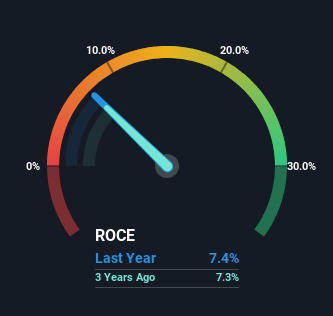Investors Met With Slowing Returns on Capital At Chesapeake Utilities (NYSE:CPK)
If you're looking for a multi-bagger, there's a few things to keep an eye out for. In a perfect world, we'd like to see a company investing more capital into its business and ideally the returns earned from that capital are also increasing. This shows us that it's a compounding machine, able to continually reinvest its earnings back into the business and generate higher returns. However, after investigating Chesapeake Utilities (NYSE:CPK), we don't think it's current trends fit the mold of a multi-bagger.
Understanding Return On Capital Employed (ROCE)
If you haven't worked with ROCE before, it measures the 'return' (pre-tax profit) a company generates from capital employed in its business. Analysts use this formula to calculate it for Chesapeake Utilities:
Return on Capital Employed = Earnings Before Interest and Tax (EBIT) ÷ (Total Assets - Current Liabilities)
0.074 = US$144m ÷ (US$2.2b - US$247m) (Based on the trailing twelve months to March 2023).
So, Chesapeake Utilities has an ROCE of 7.4%. In absolute terms, that's a low return, but it's much better than the Gas Utilities industry average of 5.3%.
View our latest analysis for Chesapeake Utilities
Above you can see how the current ROCE for Chesapeake Utilities compares to its prior returns on capital, but there's only so much you can tell from the past. If you're interested, you can view the analysts predictions in our free report on analyst forecasts for the company.
How Are Returns Trending?
In terms of Chesapeake Utilities' historical ROCE trend, it doesn't exactly demand attention. The company has consistently earned 7.4% for the last five years, and the capital employed within the business has risen 85% in that time. Given the company has increased the amount of capital employed, it appears the investments that have been made simply don't provide a high return on capital.
One more thing to note, even though ROCE has remained relatively flat over the last five years, the reduction in current liabilities to 11% of total assets, is good to see from a business owner's perspective. Effectively suppliers now fund less of the business, which can lower some elements of risk.
The Bottom Line
In summary, Chesapeake Utilities has simply been reinvesting capital and generating the same low rate of return as before. Although the market must be expecting these trends to improve because the stock has gained 57% over the last five years. Ultimately, if the underlying trends persist, we wouldn't hold our breath on it being a multi-bagger going forward.
Chesapeake Utilities does have some risks though, and we've spotted 3 warning signs for Chesapeake Utilities that you might be interested in.
While Chesapeake Utilities may not currently earn the highest returns, we've compiled a list of companies that currently earn more than 25% return on equity. Check out this free list here.
Have feedback on this article? Concerned about the content? Get in touch with us directly. Alternatively, email editorial-team (at) simplywallst.com.
This article by Simply Wall St is general in nature. We provide commentary based on historical data and analyst forecasts only using an unbiased methodology and our articles are not intended to be financial advice. It does not constitute a recommendation to buy or sell any stock, and does not take account of your objectives, or your financial situation. We aim to bring you long-term focused analysis driven by fundamental data. Note that our analysis may not factor in the latest price-sensitive company announcements or qualitative material. Simply Wall St has no position in any stocks mentioned.
Join A Paid User Research Session
You’ll receive a US$30 Amazon Gift card for 1 hour of your time while helping us build better investing tools for the individual investors like yourself. Sign up here

